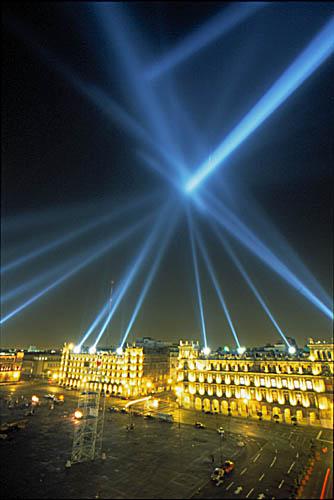Rafael Lozano-Hemmer
dal 28/5/2003 al 23/6/2003
Segnalato da
28/5/2003
Rafael Lozano-Hemmer
Alameda Art Laboratory, Mexico City
Relational Architectures. Five interactive installations will be shown, including a large-scale intervention designed specifically: a 20 meter-high colonial church nave from the XVI century. In the past fourteen years Lozano-Hemmer has developed interactive art installations that transform urban spaces and create connective environments. Using movement sensors, computer graphics, positional sound, Internet interfaces, tele-robotics and other custom-made technologies, his pieces aim to explore the intersection between architecture, interactivity and performance art.

Relational Architectures is Rafael Lozano-Hemmer’s first solo exhibition in his native Mexico. Five interactive installations will be shown, including a large-scale intervention designed specifically for the Alameda Art Laboratory main exhibit hall, a 20 meter-high colonial church nave from the XVI century. A round table discussion will take place the 29th of May at 7 PM, with the participation of philosopher and author Manuel de Landa, art historian MarÃa Fernández from Cornell University, curator Priamo Lozada and the artist.
In the past fourteen years Rafael Lozano-Hemmer has developed interactive art installations that transform urban spaces and create connective environments. Using movement sensors, computer graphics, positional sound, Internet interfaces, tele-robotics and other custom-made technologies, his pieces aim to explore the intersection between architecture, interactivity and performance art. His work has been presented in biennials in Havana, Istanbul, Graz, Valencia and Liverpool, as well as in museums and festivals worldwide.
The exhibition Relational Architectures includes the following pieces:
Frequency and Volume, Relational Architecture 9
Created specifically for the large church nave at the Alameda Art Laboratory, this installation invites members of the public to scan the radio spectrum using their bodies. A custom-made sensor tracks the projected shadows of participants, and tunes specific radio signals based on their position and size. The piece can sweep all frequencies from 150kHz to 1.5Ghz, allowing monitoring of broadcasts like air traffic control, taxi dispatch networks, wireless phones, short wave radio and many others. The installation can have up to 16 simultaneous channels of audio and the resulting sound environment is a self-organized composition controlled by people's movements. Free access to the radio spectrum, a contested public space, is presented in the context of the increased surveillance of the body.
Vectorial Elevation, Relational Architecture 4
Vectorial Elevation (1999-2002) is a large-scale interactive installation originally designed to transform Mexico City’s historic center using robotic searchlights controlled over the Internet. Visitors to the project web site at www.alzado.net could design ephemeral light sculptures with 18 xenon searchlights located around the Zócalo Square; the resulting designs could be seen from a 10-mile radius. The Mexican version of Vectorial Elevation was operative every night from dawn to dusk between December 26, 1999 and January 7, 2000. During that time, the Web site received 800,000 visits from 89 countries and all the regions of Mexico. In 2002 the installation was staged again, for the inauguration of the Basque Museum of Contemporary Art, ARTIUM, in the city of Vitoria-Gasteiz, Spain. The exhibition at the Alameda Art Lab features video, Internet and printed documentation of the Mexican and Basque versions of the project.
1000 Platitudes
A photomontage and video project featuring words commonly used to describe the generic globalized city. Each letter of the alphabet was projected on a different building using the World's most powerful projector, with 100,000 ANSI lumen intensity and images measuring up to 75 x 75 meters (250 x 250 feet). Public housing projects, shopping malls, government buildings, industrial wastelands and corporate headquarters were transformed by fast tactical projections, under the radar of potential regulators. This project was made during Lozano-Hemmer's "Huge and Mobile" (HUMO) Workshop in Linz, Austria, in early 2003.
33 Questions per Minute, Relational Architecture 5
Consists of a computer program that uses grammatical rules to combine words from the dictionary, automatically generating 55 billion unique, fortuitous questions. The automated questions are presented at a rate of 33 per minute —the threshold of legibility— on 21 tiny liquid crystal displays. The software has been programmed to avoid repeating the same question, and will take over 3 thousand years to present all the possible word combinations. A keyboard allows participants to add their own questions to the automatic flow.
The exhibition also includes a video program documenting the following pieces:
The Trace, Remote Insinuated Presence, Madrid, Spain 1994.
Displaced Emperors, Relational Architecture 2, Linz, Austria 1997.
Re:Positioning Fear, Relational Architecture 3, Graz, Austria 1997.
Body Movies, Relational Architecture 6, Rotterdam, Netherlands 2001
Two Origins, Relational Architecture 7, Toulouse, France 2002
Alameda Art Laboratory Mexico City
Dr. Mora 7 Col. Centro México, D.F.



